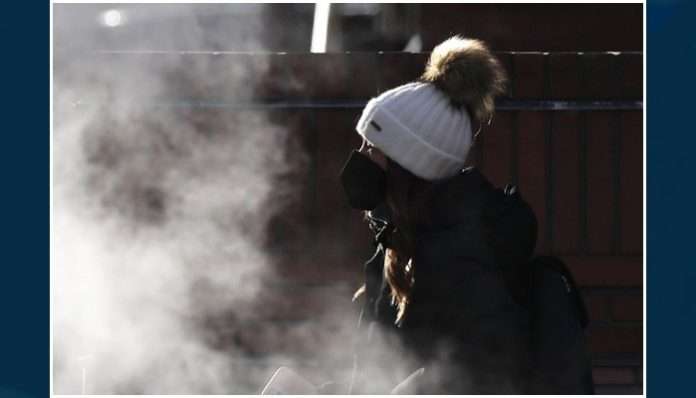
Jan. 17 (UPI) — The United States has surpassed 850,000 total COVID-19 deaths just one month after reporting 800,000 fatalities related to the virus, according to data released Sunday.
Data collected by Johns Hopkins University shows that the United States has reported 850,247 COVID-19 deaths since the start of the pandemic, along with 65,404,580 infections with a seven-day average of more than 800,000 new daily cases nationwide amid the presence of the omicron variant.
Reports of infections are up about 400% within the past two weeks in Alaska with 1,888 daily new cases at 258 per 100,000 people; Oregon at 7,670 new daily cases and 182 per 100,000; and Utah reporting 9,759 daily cases at 304 per 100,000, according to data from The New York Times.
Florida over the weekend surpassed 5 million total infections with 5,451,918, trailing only Texas at 5,522,176 and California with 6,416,171, according to CDC and state reports. In the most recent daily data, Florida added 49,339 cases Saturday, California 119,264 Friday, and Texas 50,151. New York reported 51,264 and is fourth at 4,507,344.
A total of 156,874 inpatient beds at more than 6,000 hospitals nationwide are in use for COVID-19 patients, accounting for 20.44%, according to Department of Health and Human Services data. One day earlier it was a record 158,263 with 10 more hospitals reporting.
On Thursday, President Joe Biden announced he was sending more than 100 military medical personnel to overcrowded hospitals in six states — Michigan, New Jersey, New Mexico, New York, Ohio and Rhode Island — to assist with the surge.
U.S. Surgeon General Dr. Vivek Murthy on Sunday told CNN’s “State of the Union” that while New York, which reported a 47% drop in COVID-19 cases on Saturday, and other parts of the Northeast are beginning to see plateaus and declines in COVID-19 cases, “the entire country is not moving at the same pace” creating a challenge for health officials.
“The omicron wave started later in other parts of the country. So we shouldn’t expect a national peak in the next coming days,” said Murthy. “The next few weeks will be tough.”
Murthy urged Americans to get vaccinated and receive a booster shot to protect themselves from the virus, telling ABC News’ “This Week” that data shows 75%-85% protection against symptomatic infection among boosted individuals.
“That means there’s about 20% possibility there in terms of positive cases despite being … vaccinated compared to an unvaccinated population,” he said. “But, keep in mind, that still shows a very strong efficacy overall against symptomatic disease.”
As of Saturday, 248,707,432 people, or 74.9% of the U.S. population, have received at least one COVID-19 vaccine dose while 208,995,438, or 62.9% of the population, have completed their vaccine regimen, according to Centers for Disease Control and Prevention data. Among people who have completed their vaccine sequence, 38.1% have received an additional booster shot.
Demand for testing has surged since the arrival of omicron and the Biden administration announced it had issued guidance requiring private health insurers to reimburse Americans for the cost of eight over-the-counter at-home COVID-19 tests per month.
On Friday, the White House said a new website — COVIDTest.gov — will go live on Wednesday, allowing Americans to order up to four at-home tests per household after Biden pledged to make 500 million tests available to Americans for free and on Thursday said he plans to order an additional 500 million tests.
Maryland Gov. Larry Hogan was critical of the speed at which the White House deployed the tests, telling CBS News’ “Face the Nation” that “so far we haven’t seen any” as the state has been acquiring its own tests.
“Now it appears as if, rather than producing more of these rapid tests, the federal government is just purchasing the ones that we had already contracted for,” said Hogan. “You know, so now we’re sort of hijacking the tests that we already had plans for and we’re now getting some of those providers to tell us they no longer have the rapid tests.”
Murthy said that the administration has seen a “more than eightfold increase in testing” between January and December of 2021, but added it still struggled to keep pace with demand brought on by the omicron surge.
“The challenge was that omicron created an extraordinary increase in demand even beyond the incredible increase in supply that we had procured and secured during 2021,” he said. “So we have to close that gap, and that’s exactly what we have been doing. It’s what we plan to keep doing.”
Murthy also touted the availability of COVID-19 therapeutics, including antiviral pills from Pfizer and Merck as well as three intravenous medications as pivotal tools in combating the virus alongside vaccination and testing.
“You put all of this together and that’s where you see we have more supply in January than we have had in any other month,” said Murthy. “But we’re not stopping there. We are continuing to increase month by month our supply, so that we can get those medications to people who are sick, who are at high risk, and ultimately, save their lives.”





